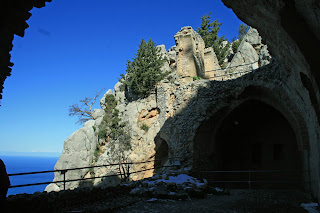In writing about Medieval Cyprus it is impossible to overlook the most powerful and dramatic of all the medieval fortresses: St. Hilarion. It is the setting of several key historical episodes that inherently fall within the framework of my novels -- and I couldn't resist using it for fictional episodes as well. Below is a brief history.
The castle stands 700 meters (2275 feet) above sea level on the narrow ridge of the Kyrenia range just slightly southwest of the port of Kyrenia. It was built by the Byzantine governor of the island after the Comnenus emperors re-established full control over Cyprus in the late 10th. Constructed between 1102 and 1110, it was called Didymos by the Byzantines for the twin mountain peaks between which the upper castle sits. The crusaders, however, preferred to call it the castle of "Dieu d'Amour" (the God of Love) and the locals continued to refer to it as St. Hilarion because the saint of that name had built a monastery, been buried and venerated here long before the castle was built.
Remnants of the Castle Church
View from the upper to the lower ward.
In July/August 1228, after Emperor Friedrich II accused John d'Ibelin of malfeasance and attempted to seize his fief without trial, Ibelin secured control of St. Hilarion, had it well provisioned and moved his supporters' dependents there in preparation for a confrontation. Ibelin was persuaded to turn the castle over to the King of Cyprus in exchange for the release of his two hostage sons -- or vice versa, depending on how one interprets the negotiations.
When Friedrich II left the Holy Land for the West, he turned St. Hilarion over to his appointed baillies with orders for them to prevent the Ibelins from setting foot on the island. Within two months, however, the Ibelins had pulled together a sufficient army to challenge this (illegal) order head on. They landed on the south coast and routed the imperial forces at the Battle of Nicosia on July 14, 1229. The surviving leaders of the imperial supporters fled to the three mountain castles, Kantara, Buffavento and St. Hilarion. A siege began almost at once that lasted nearly a year. Shortly after Easter in 1230, the Imperial forces surrendered to the Ibelins.
Just two years later, in May 1232, fortunes were reversed. The Imperial forces were on the offensive. With the Lord of Beirut, all his sons and the bulk of his knights struggling to relieve a besieged Beirut, the Imperial forces seized control of Cyprus. The supporters of the Ibelins were forced to seek refuge in St. Hilarion and Buffavento, where they were soon subjected to a siege. Six weeks later, after defeating the Imperial forces at the Battle of Argidi on June 15, 1232, the Ibelins were able to lift the siege of St. Hilarion and rescue their women and children.
A long period of peace followed this episode, and St. Hilarion was strengthened and embellished by the Lusignan kings to turn it into an idyllic summer residence high above the heat of the coast. In 1348, King Hugh IV retreated to the castle to escape not an enemy but the plague. During the later Genoese invasion, St. Hilarion was an important royal base of operations, the key to disrupting Genoese internal lines of communication.
After that, like Kantara, it lost relevance and fell into disrepair and finally ruin from the 16th century onwards.
St. Hilarion is the setting of important historical events described in "Rebels against Tyranny."
Buy Now!
Dr. Helena P. Schrader holds a PhD in History.
She is the Chief Editor of the Real Crusades History Blog.
She is an award-winning novelist and author of numerous books both fiction and non-fiction. Her three-part biography of Balian d'Ibelin won a total of 14 literary accolades. Her most recent release is a novel about the founding of the crusader Kingdom of Cyprus. You can find out more at: http://crusaderkingdoms.com









No comments:
Post a Comment
I welcome feedback and guest bloggers, but will delete offensive, insulting, racist or hate-inciting comments. Thank you for respecting the rules of this blog.